主谓一致——就近原则
- 格式:doc
- 大小:79.00 KB
- 文档页数:11
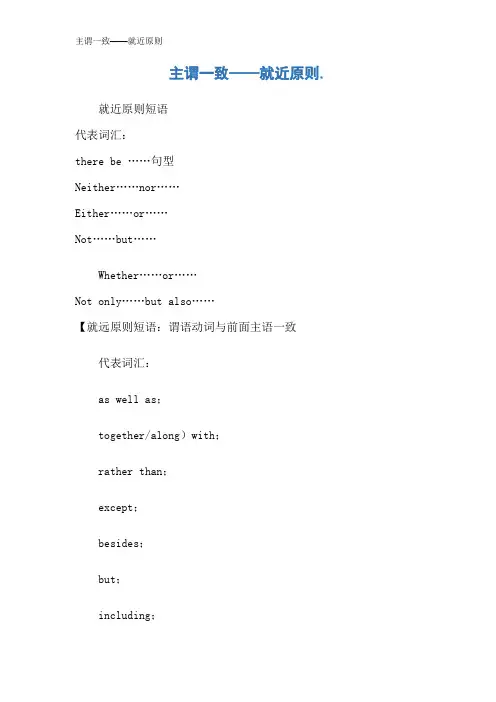
主谓一致——就近原则.就近原则短语代表词汇:there be ……句型Neither……nor……Either……or……Not……but……Whether……or……Not only……but also……【就远原则短语:谓语动词与前面主语一致代表词汇:as well as;together/along)with;rather than;except;besides;but;including;in addition to;apart from例如:He rather than I is right.Nobody but two students is in the classroom.主谓一致现象。
有一类连接词,其后的谓语动词要与连接词前一部分的主语保持一致。
此类连接词有with, along with, together with, as well as, besides, like, without, except (but), including等。
例如:Tracy, like many girls, loves dancing. 特蕾西像很多女孩一样,喜欢跳舞。
All the students, including Tom, are leaving. 所有的学生,包括汤姆都走了。
No one except (but) me knows about this news. 除了我没有人知道这个消息。
就近原则现象。
还有另一类连接词,句中的谓语动词要与靠近的主语保持一致。
此类连接词有or, either... or, neither...nor, not only... but also等。
例如:Neither you nor I am wrong. 你和我都没错。
Not only the students but also the teacher wishes for a holiday. 不仅是学生,就连老师也期盼一个假期。
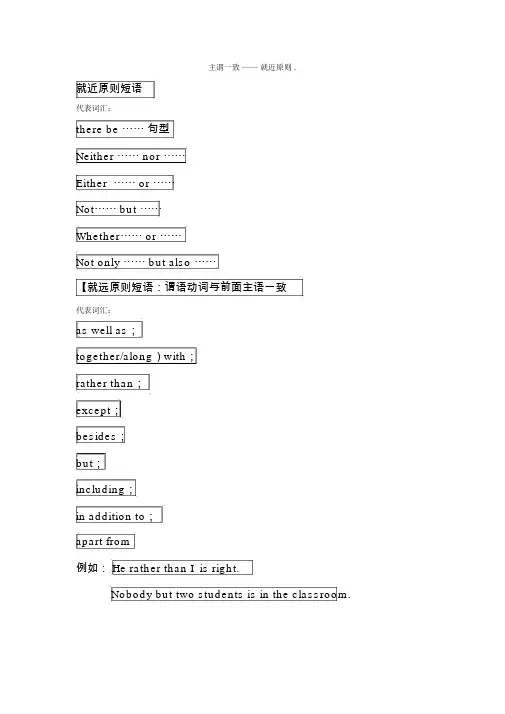
主谓一致——就近原则 .就近原则短语代表词汇:there be ⋯⋯句型Neither ⋯⋯ nor ⋯⋯Either ⋯⋯ or ⋯⋯Not⋯⋯ but ⋯⋯Whether⋯⋯ or ⋯⋯Not only ⋯⋯ but also ⋯⋯【就远原则短语:谓语动词与前面主语一致代表词汇:as well as;together/along)with;rather than;except;besides;but;including;in addition to;apart from例如: He rather than I is right.Nobody but two students is in the classroom.主谓一致现象。
有一类连接词,其后的谓语动词要与连接词前一部分的主语保持一致。
此类连接词有with, along with, together with, as well as, besides, like, without, except (but), including等。
例如:Tracy, like many girls, loves dancing.特蕾西像很多女孩一样,喜欢跳舞。
All the students, including Tom, are leaving.所有的学生,包括汤姆都走了。
No one except (but) me knows about this news. 除了我没有人知道这个消息。
就近原则现象。
还有另一类连接词,句中的谓语动词要与靠近的主语保持一致。
此类连接词有or, either... or, neither...nor, not only... but also 等。
例如:Neither you nor I am wrong.你和我都没错。
Not only the students but also the teacher wishes for a holiday. 不仅是学生,就连老师也期盼一个假期。

主谓一致主谓一致是指两个语法成分,即主语和谓语,之间的协调成分。
在英语中,主谓一致主要是指用作主语的名词或代词和用作谓语的动词在人称、数、性格等方面的一致。
通常遵循三个原则,即就近原则和语法原则。
1.就近原则谓语动词的单、复数形式取决于最靠近它的词语(主要指名词或代词)的单、复数形式,这种一致关系所依据的原则叫做“就近原则”。
(1)在“名(代)词+or+名(代)词”结构后的动词一般应与or后的名(代)词一致。
He or his brothers were to blame .应该怪他或他的兄弟们。
You or Mary is going to meet them at the station this afternoon .今天下午你或玛丽将到火车站接他们。
(2)“either+名(代)词+or +名(代)词”结构后的动词一般应与or后的名(代)词一致。
Either the shirts or the sweater is a good buy这些衬衣,或者这件毛衣,买了是会合算的。
Either dye or oil paints are used to colour cloth .给布料上色要么用染料,要么用油漆。
(3)“not only +名(代)词+but (also)+名(代)词”结构后的动词一般应与but(also)后的名(代)词一致。
Not only the students but also their teacher is enjooying the film.不仅学生们在欣赏这部电影,他们的老师也在欣赏这部电影。
Not only our society but also the people in it have changed .不仅是他父母,而且他本人都想团聚在一起。
(4)“neither +名(代)词+nor +名(代)词”结构后的动词一般应与nor 后的名(代)词一致。

主谓一致——就近原则.代表词汇:主谓一致现象。
有一类连接词,其后的谓语动词要与连接词前一部分的主语保持一致。
此类连接词有with, along with, together with, as well as, besides, like, without, except (but), including等。
例如:Tracy, like many girls, loves dancing. 特蕾西像很多女孩一样,喜欢跳舞。
All the students, including Tom, are leaving. 所有的学生,包括汤姆都走了。
No one except (but) me knows about this news. 除了我没有人知道这个消息。
就近原则现象。
还有另一类连接词,句中的谓语动词要与靠近的主语保持一致。
此类连接词有or, either... or, neither...nor, notonly... but also等。
例如:Neither you nor I am wrong. 你和我都没错。
Not only the students but also the teacher wishes for a holiday. 不仅是学生,就连老师也期盼一个假期。
1.There be 句型There is a book and some pencils on the desk.=There are some pencils and a book on the desk.2.neither...nor... Neither you nor he is right.= Neither he nor you are right.3.either...or... Either they or Jim is going to Shanghai next Saturday.= Either Jim or they are going to shanghai next Saturday.4.not only...but also... Not only Ann but also her parents stay at home every Sunday.= Not only Ann's parents but also she stays at home every Sunday.百度词条:就近原则也称“邻近原则”“就近一致原则”(Proximity),即:谓语与靠近的名词、代词(有时不一定是主语)在“人称、数”上一致。

主谓一致 就近原则.代表词汇:Neither ....... n orWhether ...... o r ........Not only ...... but also .........bxcep ;besides but ; including;例如:IHe rather than I is right. Nobody but two StUdentS is in the CIaSSrodm.主谓一致现象。
有一类连接词,其后的谓语动词要与连接词前一部分的主语保持一致。
此类连接词有with, along with, together with, as well as, besides, like, without, except (but), including 等。
例如:Tracy, like many girls, loves dancing. 特蕾西像很多女孩一样,喜欢跳舞。
All the students, including Tom, are leaving. 所有的学生,包括汤姆都走了。
No one except (but) me knows about this news. 除了我没有人知道这个消息。
就近原则现象。
还有另一类连接词,句中的谓语动词要与靠近的主语保持一致。
此类连接词有or, either... or, neither...nor, not only... but also 等。
例如:Neither you nor I am wrong. 你和我都没错。
Not only the students but also the teacher wishes for a holiday. 不仅是学生,就连老师也期盼一个假期。
1. There be 句型There is a book and some pencils on the desk.=There are some pencils and a book on the desk.2. neither...nor... Neither you nor he is right.= Neither he nor you are right.3. either...or... Either they or Jim is going to Shanghai next Saturday.= Either Jim or they are going to shanghai next Saturday.4. not only...but also... Not only Ann but also her parents stay at home every Sunday.= Not only Ann's parents but also she stays at home every Sunday.百度词条:就近原则也称邻近原则”就近一致原则”(Proximity),即:谓语与靠近的名词、代词(有时不一定是主语)在人称、数”上一致。
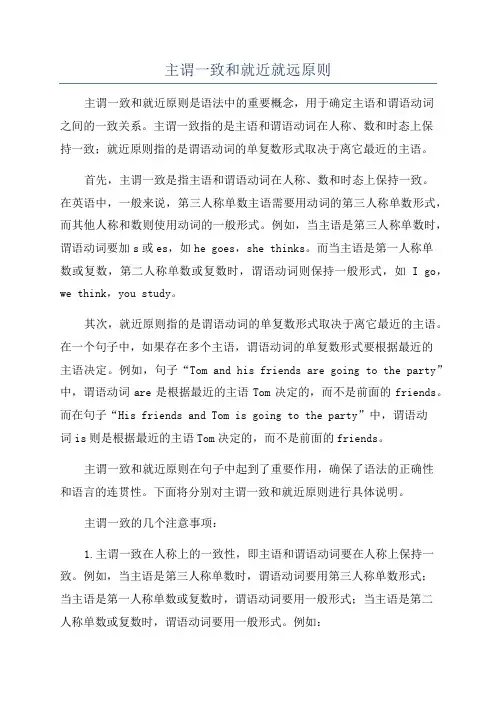
主谓一致和就近就远原则主谓一致和就近原则是语法中的重要概念,用于确定主语和谓语动词之间的一致关系。
主谓一致指的是主语和谓语动词在人称、数和时态上保持一致;就近原则指的是谓语动词的单复数形式取决于离它最近的主语。
首先,主谓一致是指主语和谓语动词在人称、数和时态上保持一致。
在英语中,一般来说,第三人称单数主语需要用动词的第三人称单数形式,而其他人称和数则使用动词的一般形式。
例如,当主语是第三人称单数时,谓语动词要加s或es,如he goes,she thinks。
而当主语是第一人称单数或复数,第二人称单数或复数时,谓语动词则保持一般形式,如I go,we think,you study。
其次,就近原则指的是谓语动词的单复数形式取决于离它最近的主语。
在一个句子中,如果存在多个主语,谓语动词的单复数形式要根据最近的主语决定。
例如,句子“Tom and his friends are going to the party”中,谓语动词are是根据最近的主语Tom决定的,而不是前面的friends。
而在句子“His friends and Tom is going to the party”中,谓语动词is则是根据最近的主语Tom决定的,而不是前面的friends。
主谓一致和就近原则在句子中起到了重要作用,确保了语法的正确性和语言的连贯性。
下面将分别对主谓一致和就近原则进行具体说明。
主谓一致的几个注意事项:1.主谓一致在人称上的一致性,即主语和谓语动词要在人称上保持一致。
例如,当主语是第三人称单数时,谓语动词要用第三人称单数形式;当主语是第一人称单数或复数时,谓语动词要用一般形式;当主语是第二人称单数或复数时,谓语动词要用一般形式。
例如:- She goes to school every day.(第三人称单数,谓语动词用第三人称单数形式)- They go to school every day.(第三人称复数,谓语动词用一般形式)- I go to school every day.(第一人称单数,谓语动词用一般形式)- We go to school every day.(第一人称复数,谓语动词用一般形式)- You go to school every day.(第二人称单数或复数,谓语动词用一般形式)2.主谓一致在数上的一致性,即主语和谓语动词要在数上保持一致。
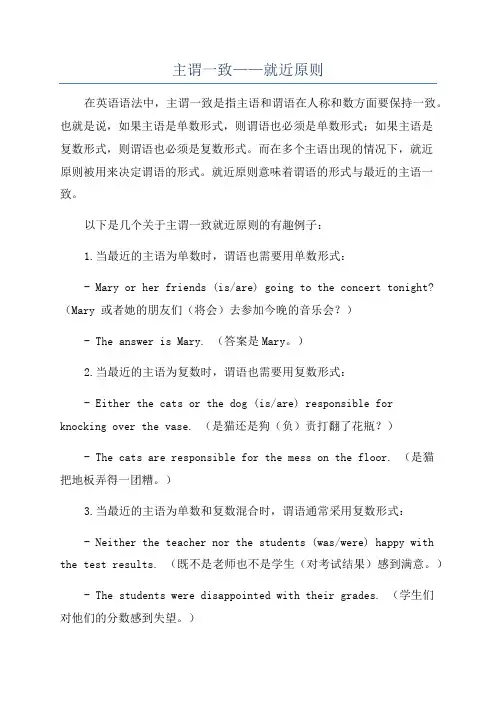
主谓一致——就近原则在英语语法中,主谓一致是指主语和谓语在人称和数方面要保持一致。
也就是说,如果主语是单数形式,则谓语也必须是单数形式;如果主语是复数形式,则谓语也必须是复数形式。
而在多个主语出现的情况下,就近原则被用来决定谓语的形式。
就近原则意味着谓语的形式与最近的主语一致。
以下是几个关于主谓一致就近原则的有趣例子:1.当最近的主语为单数时,谓语也需要用单数形式:- Mary or her friends (is/are) going to the concert tonight? (Mary 或者她的朋友们(将会)去参加今晚的音乐会?)- The answer is Mary. (答案是Mary。
)2.当最近的主语为复数时,谓语也需要用复数形式:- Either the cats or the dog (is/are) responsible for knocking over the vase. (是猫还是狗(负)责打翻了花瓶?)- The cats are responsible for the mess on the floor. (是猫把地板弄得一团糟。
)3.当最近的主语为单数和复数混合时,谓语通常采用复数形式:- Neither the teacher nor the students (was/were) happy with the test results. (既不是老师也不是学生(对考试结果)感到满意。
)- The students were disappointed with their grades. (学生们对他们的分数感到失望。
)4.当最近的主语为两个同一类的名词时,谓语通常与最近的主语保持一致:- The cat and the dog (is/are) playing in the garden. (猫和狗(在花园里)玩耍。
)- The cat is chasing the dog. (猫正在追逐狗。

主谓一致——就近原则.代表词汇:代表词汇:主谓一致现象。
有一类连接词,其后的谓语动词要与连接词前一部分的主语保持一致。
此类连接词有with, along with, together with, as well as, besides, like, without, except (but), including等。
例如:Tracy, like many girls, loves dancing. 特蕾西像很多女孩一样,喜欢跳舞。
All the students, including Tom, are leaving. 所有的学生,包括汤姆都走了。
No one except (but) me knows about this news. 除了我没有人知道这个消息。
就近原则现象。
还有另一类连接词,句中的谓语动词要与靠近的主语保持一致。
此类连接词有or, either... or, neither...nor, not only... but also等。
例如:Neither you nor I am wrong. 你和我都没错。
Not only the students but also the teacher wishes for a holiday. 不仅是学生,就连老师也期盼一个假期。
1.There be 句型There is a book and some pencils on the desk.=There are some pencils and a book on the desk.2.neither...nor... Neither you nor he is right.= Neither he nor you are right.3.either...or... Either they or Jim is going to Shanghai next Saturday.= Either Jim or they are going to shanghai next Saturday.4.not only...but also... Not only Ann but also her parents stay at home every Sunday.= Not only Ann's parents but also she stays at home every Sunday.百度词条:就近原则也称“邻近原则”“就近一致原则”(Proximity),即:谓语与靠近的名词、代词(有时不一定是主语)在“人称、数”上一致。
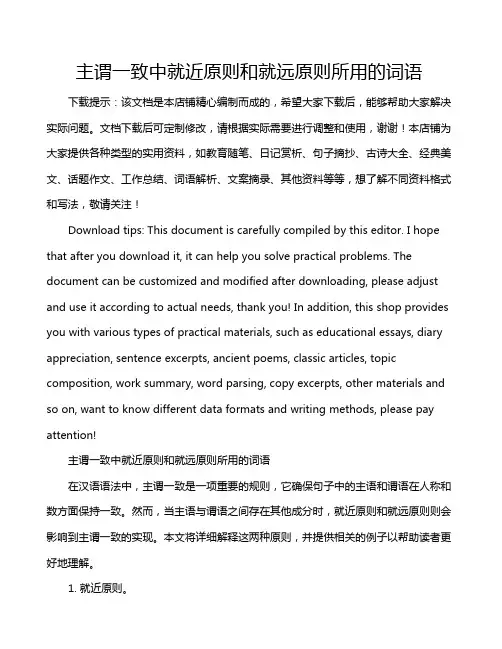
主谓一致中就近原则和就远原则所用的词语下载提示:该文档是本店铺精心编制而成的,希望大家下载后,能够帮助大家解决实际问题。
文档下载后可定制修改,请根据实际需要进行调整和使用,谢谢!本店铺为大家提供各种类型的实用资料,如教育随笔、日记赏析、句子摘抄、古诗大全、经典美文、话题作文、工作总结、词语解析、文案摘录、其他资料等等,想了解不同资料格式和写法,敬请关注!Download tips: This document is carefully compiled by this editor. I hope that after you download it, it can help you solve practical problems. The document can be customized and modified after downloading, please adjust and use it according to actual needs, thank you! In addition, this shop provides you with various types of practical materials, such as educational essays, diary appreciation, sentence excerpts, ancient poems, classic articles, topic composition, work summary, word parsing, copy excerpts, other materials and so on, want to know different data formats and writing methods, please pay attention!主谓一致中就近原则和就远原则所用的词语在汉语语法中,主谓一致是一项重要的规则,它确保句子中的主语和谓语在人称和数方面保持一致。
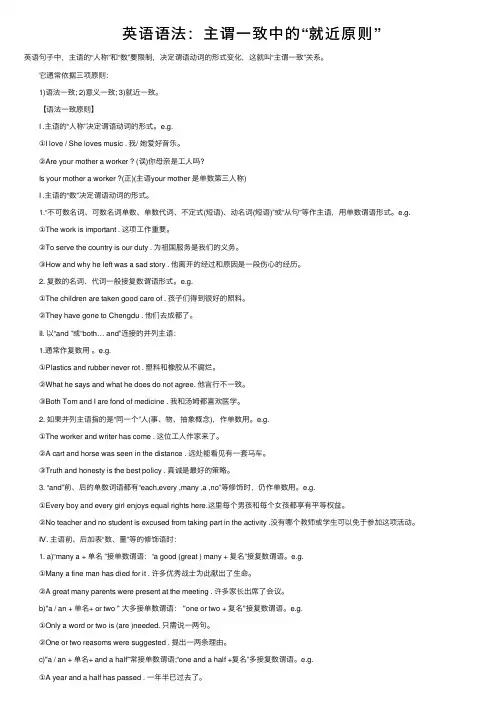
英语语法:主谓⼀致中的“就近原则”英语句⼦中,主语的“⼈称”和“数”要限制,决定谓语动词的形式变化,这就叫“主谓⼀致”关系。
它通常依据三项原则: 1)语法⼀致; 2)意义⼀致; 3)就近⼀致。
【语法⼀致原则】 I .主语的“⼈称”决定谓语动词的形式。
e.g. ①I love / She loves music . 我/ 她爱好⾳乐。
②Are your mother a worker ? (误)你母亲是⼯⼈吗? Is your mother a worker ?(正)(主语your mother 是单数第三⼈称) I .主语的“数”决定谓语动词的形式。
1.“不可数名词、可数名词单数、单数代词、不定式(短语)、动名词(短语)”或“从句”等作主语,⽤单数谓语形式。
e.g. ①The work is important . 这项⼯作重要。
②To serve the country is our duty . 为祖国服务是我们的义务。
③How and why he left was a sad story . 他离开的经过和原因是⼀段伤⼼的经历。
2. 复数的名词、代词⼀般接复数谓语形式。
e.g. ①The children are taken good care of . 孩⼦们得到很好的照料。
②They have gone to Chengdu . 他们去成都了。
II. 以“and ”或“both… and”连接的并列主语: 1.通常作复数⽤。
e.g. ①Plastics and rubber never rot . 塑料和橡胶从不腐烂。
②What he says and what he does do not agree. 他⾔⾏不⼀致。
③Both Tom and I are fond of medicine . 我和汤姆都喜欢医学。
2. 如果并列主语指的是“同⼀个”⼈(事、物、抽象概念),作单数⽤。

英语主谓一致中就近原则和就远原则在英语语法中,主谓一致是指谓语动词必须与其所修饰的主语在人称和数上保持一致。
这个规则在句子中起着非常重要的作用,使得句子更加清晰和易于理解。
然而,当主词由两个或更多个名词组成时,就会出现就近原则和就远原则的问题。
下面将详细讨论这两个概念以及它们在主谓一致中的应用。
就近原则和就远原则在主谓一致中的作用是解决由并列结构引起的冲突。
并列结构是指由连词连接的两个或更多个并列成分,这些成分通常由并列连词(如and、or、but等)引导。
当并列成分之间存在谓语动词时,就需要根据主谓一致原则来确定谓语动词的形式。
就近原则(Proximity Agreement)是指谓语动词的形式应该与离它最近的主语保持一致。
这意味着当主语由并列结构组成时,谓语动词应该与最近的主语在人称和数上保持一致。
例如:1. My friend and I are going to the party.(我的朋友和我要去参加派对。
)2. The dog and the cat are playing in the garden.(狗和猫在花园里玩。
)在第一个例子中,谓语动词are与最近的主语I保持一致。
在第二个例子中,谓语动词are与最近的主语cat保持一致。
然而,就近原则并不是绝对的规则。
在一些情况下,就近原则会被就远原则(Proximity Disagreement)所取代。
就远原则是指谓语动词的形式应该与其中一个主语保持一致,通常是离谓语动词更远的主语。
这种情况下,就远原则一般出现在最近的主语和谓语动词之间有插入语的情况下。
例如:1. The cat, along with the dogs, is sleeping.(猫和狗们都在睡觉。
)2. My sister, as well as her friends, is going on the trip.(我姐姐和她的朋友们都要去旅行。
)在第一个例子中,虽然最近的主语是dogs,但是由于插入语along with独立于并列结构之外,因此谓语动词is与最远的主语cat保持一致。
英语语法中几个就近原则在英语语法中有几个就近原则,它们是:1.主谓一致的就近原则(Proximity Agreement in Subject-Verb Agreement):当主语由两个或更多个单数名词或代词组成,并且连接词为"and"时,谓语动词应与最靠近它的名词或代词在数上一致。
例如:The book and the pen are on the table. (书和笔在桌子上。
)2. 反身代词的就近原则(Proximity Agreement in Reflexive Pronouns):当反身代词作为主语时,它应该与最靠近它的名词在人称和数上一致。
例如:John and his sister bought themselves new clothes.(约翰和他的姐姐给自己买了新衣服。
)3. 代词的就近指代原则(Proximity Agreement in Pronoun Reference):当一个名词或该名词的同位语和一个代词一起使用时,代词应该与最靠近它的名词或同位语在人称、数、性别和格上一致。
例如:Peter and his friends played a game. They won. (彼得和他的朋友们玩了一场比赛。
他们赢了。
)4. 介词短语的就近修饰原则(Proximity Agreement in Prepositional Phrase Modifiers):当一个名词有多个介词短语修饰时,这些介词短语应该紧密地连接到最靠近它的名词上,以避免歧义。
例如:The girl in the red dress with a hat is my sister.(穿着红色连衣裙戴着帽子的女孩是我妹妹。
)5. 修饰语的就近修饰原则(Proximity Agreement in Modifier Placement):修饰语应尽可能地靠近它所修饰的词,以避免歧义。
主谓一致就近原则
主谓一致是指句子中的主语和谓语在人称和数方面要保持一致。
就近
原则是指当主语由多个名词或代词构成时,谓语动词的形式与离其最近的
名词或代词保持一致。
主谓一致使得句子更加流畅和易于理解,同时也能避免产生语法错误。
就近原则则是在主语由多个名词或代词组成时,选择离谓语动词最近的名
词或代词来决定谓语动词的形式。
下面是一些主谓一致和就近原则的例子:1.单个主语的情况:
- The cat is sleeping.(猫在睡觉)
- He is playing basketball.(他在打篮球)
2.多个主语的情况:
- The cat and the dog are playing.(猫和狗在玩耍)
- She and her brother are studying.(她和她哥在学习)
3.就近原则的应用:
- Neither the students nor the teacher is happy.(学生和老师
都不开心)
- Either the cat or the dogs are responsible for the mess.
(是猫还是狗造成了这一困境)
总结起来,主谓一致和就近原则对于正确使用英语语法至关重要。
在
撰写文章或交流时,我们应该注意主语和谓语之间的一致性,并根据就近
原则选择正确的动词形式。
这样能够使我们的语言更加准确和流利。
主谓一致是指主语和谓语在人称和数上保持一致的语法现象。
就近原则是指谓语动词的单复数形式应与离它最近的主语保持一致。
在九年义务初中英语中,主谓一致就近原则是一个经常出现的考点,下面对该知识进行梳理。
一、主谓一致的基本规则1.如果主语是单数第三人称,谓语动词要用单数形式。
例如:- Jane reads books in the library. (主语是单数第三人称,谓语动词用单数形式reads)2.如果主语是复数第一人称,谓语动词要用复数形式。
例如:- We play football after school. (主语是复数第一人称,谓语动词用复数形式play)3.如果主语是复数第二人称或复数第三人称,谓语动词要用复数形式。
例如:- You are students. (主语是复数第二人称,谓语动词用复数形式are)- They like swimming. (主语是复数第三人称,谓语动词用复数形式like)4.如果主语是单数第一人称,谓语动词可以用单数或复数形式。
例如:- I am a student. (主语是单数第一人称,谓语动词可以用单数形式am)- I like swimming. (主语是单数第一人称,谓语动词可以用复数形式like)5.当主语是由两个或两个以上的名词作并列结构时,谓语动词要用复数形式。
例如:- Tom and Jerry are good friends. (主语由Tom和Jerry构成,谓语动词用复数形式are)二、主谓一致的就近原则就近原则是指谓语动词的单复数形式应与离它最近的主语保持一致。
具体规则如下:1. 如果两个或两个以上的名词作并列主语,用and连接时,谓语动词要用复数形式。
例如:- Tom and Jerry are good friends. (主语Tom和Jerry是并列主语,谓语动词用复数形式are)2.如果并列主语中有一个是单数,另一个是复数,谓语动词应与距离它更近的主语保持一致。
英语就近原则一、什么是就近原则?就近原则指的是主谓一致中的一种情况,由于在英语中一个句子的主语有时候并不是一个,而是出现多个主语,这些主语由并列连词连接起来,共用一个谓语,那么这个谓语动词就要和最靠近它的主语在人称和数上保持一致。
二、就近原则常见结构1、由并列连词or连接的多个主语,谓语动词要遵循就近原则。
例句1:You, he or I am allowed to leave the office.译文1:你,我或者他被允许离开办公室。
解析1:句中or连接了三个主语you,he和I,谓语动词be 最靠近主语I,所以be动词要选择am。
例句2:You or he is to blame.译文2:你或者他该受责备。
解析2:句中or连接了两个主语you和he,谓语动词be最靠近主语he,所以be动词要选择is。
2、由并列连词either···or···连接的两个主语,谓语动词要遵循就近原则。
例句1:Either you or Mike is wrong.译文1:要么你错要么迈克错。
解析1:句中谓语动词be靠近主语Mike,Mike是单数第三人称,所以be动词要用is。
例句2:Either the teacher or the students are right.译文2:不是老师正确,就是学生正确。
解析2:句中谓语动词be靠近主语the students,the students 是复数第三人称,所以be动词要用are。
3、由并列连词neither···nor···连接的两个主语,谓语动词要遵循就近原则。
例句1:Neither you nor your brother likes playing football.译文1:你和你弟弟都不喜欢踢足球。
解析1:句中谓语动词like靠近单数第三人称your brother,所以动词like要变单三形式likes。
主谓一致——就近原则.代表词汇:代表词汇:主谓一致现象。
有一类连接词,其后的谓语动词要与连接词前一部分的主语保持一致。
此类连接词有with, along with, together with, as well as, besides, like, without, except (but), including等。
例如:Tracy, like many girls, loves dancing. 特蕾西像很多女孩一样,喜欢跳舞。
All the students, including Tom, are leaving. 所有的学生,包括汤姆都走了。
No one except (but) me knows about this news. 除了我没有人知道这个消息。
就近原则现象。
还有另一类连接词,句中的谓语动词要与靠近的主语保持一致。
此类连接词有or, either... or, neither...nor, not only... but also等。
例如:Neither you nor I am wrong. 你和我都没错。
Not only the students but also the teacher wishes for a holiday. 不仅是学生,就连老师也期盼一个假期。
1.There be 句型There is a book and some pencils on the desk.=There are some pencils and a book on the desk.2.neither...nor... Neither you nor he is right.= Neither he nor you are right.3.either...or... Either they or Jim is going to Shanghai next Saturday.= Either Jim or they are going to shanghai next Saturday.4.not only...but also... Not only Ann but also her parents stay at home every Sunday.= Not only Ann's parents but also she stays at home every Sunday.百度词条:就近原则也称“邻近原则”“就近一致原则”(Proximity),即:谓语与靠近的名词、代词(有时不一定是主语)在“人称、数”上一致。
I.在正式文体中:1.由下列词语连接的并列主语:"or ; either …or;nor; neither…or;whether…or;not…but; not only…but also" ; 等。
e.g.①What he does or what he says does not concern me . 他的行为或言谈都与我无关。
②Neither you nor I am wrong . 你和我都没错。
③Not you but your father is to blame . 不是你,而是你父亲该受责备。
④Not only you hut(also) he is wrong .不仅你错了,他也错了。
2. 在倒装句中:谓语可与后面第一个主语一致。
e.g.①In the distance was heard the clapping of hands and the shouts of the people . 在远处,能听见鼓掌声和人们的呼喊声。
②There is (are) a pen and some books on the desk .桌上有一支钢笔和几本书。
II. 非正式文体中:有时依“就近一致原则”,但也可依“意义一致原则”或严格地依“语法一致原则”。
e.g.Neither she nor I were there (意义一致) 我和他当时都不在那儿。
(非正式)Neither she nor I was there .(就近一致)(译文同上句)(正式)但是,如果依“就近一致原则”而与其他两项原则相矛盾时,则常常认为是不太合符规范的。
e.g.No one except his own supporters agree(s) with him .仅他自己的支持者同意他的意见。
(依“就近”和“意义”一致的原则;但语法上,“No one ”才是主语,谓语要改成“agrees”。
“写作中”一般要依“语法一致”原则。
主谓一致分为两大类:就近一致原则和意义一致原则。
就近一致原则指的是,以靠近谓语动词的,作主语的名词作为人称和数的参考标准。
意义一致原则指的是,必须分析主语属于单数或是复数,可数或是不可数,然后才能决定谓语动词的人称和数的形式。
就近一致原则(1)连词not only...but also/ neither...nor/ or/ either...or/ not...but<><><>Not only the students but also the teacher is enjoying the film.不仅学生而且老师都在津津乐道地看着电影。
Neither the students nor the teacher knows anything about it.同学们和老师对此都一无所知。
Neither he nor they are wholly right.他和他们,谁都不是完全对的。
Either he or I am right.或者他对,或者我对。
就近一致原则(2)副词here/ there<><><>Here comes the bus.瞧,公共汽车来了。
Here is a pencil-box for you.这儿有一个铅笔盒要给你。
Here are my replies to your questions.这些是我针对你的问题的回答。
There is an apple, two bananas and some oranges on the plates. 盘子里有一个苹果,两条香蕉和一些桔子。
主谓一致:andand的两边分别是不同的可数名词。
John and Mary are my friends.约翰和玛丽都是我的朋友。
<><><>and的两边分别是不同的不可数名词。
Both rice and wheat are grown in China.中国有种水稻也有种小麦。
<><><>and的两边的单词构成一个统一的概念。
Fish and chips is a popular supper here.炸鱼土豆片在这里是一种很受欢迎的晚餐。
(鱼和土豆片作为整体)The poet and writer has come.那位诗人兼作家来了。
(同一个人既是诗人又是作家)主谓一致指的是句子的谓语动词与其主语在数上必须保持一致,句子的主语是第三人称单数,其谓语动词须用单数,主语是复数,则谓语动词用复数。
1.主谓一致的三个原则。
英语中的主谓一致主要遵循三个原则:意义一致原则、语法一致原则和就近原则。
这三个原则常常发生矛盾,但当发生冲突时,意义一致原则为优先考虑的原则。
(1)语法一致原则:主语和谓语通常是在语法形式上取得一致,即主语是单数形式,谓语动词也应采取单数形式;主语是复数形式,谓语动词也应采取复数形式。
She is a girl.她是女孩。
They are all girls.她们都是女孩。
The professor and writer is invited to many universities to deliver lectures.这位教授兼作家被邀请到很多大学作报告。
(教授与作家是同一个人,是单数.)The old are very well taken care of in our city.老年人在我们城市被照顾得很好。
( the old 指所有的老年人,指一类人,为复数概念。
)(2)就近原则:谓语动词的人称和数由靠近它的主语决定。
There is a book,two pens and three pencils on the desk.书桌上有一本书,两支钢笔和三支铅笔。
There are two pens,a book and three pencils on the desk.书桌上有两支钢笔,一本书和三支铅笔。
Either my sisters or my mother is coming.不是我的姐妹们就是我的妈妈要来。
(3)意义一致原则:主语形式上是单数,但表达复数意义,那么谓语动词要用复数形式;或主语形式上是复数,但表达单数意义,则谓语动词也采用单数形式。
The police are still running after the murderer.警察还在追杀人犯。
The news was very exciting.这则新闻令人激动。
My family were watching TV at 7 o'clock.7点钟的时候,我们全家人在看电视。
My family has moved three times.我们家搬过三次。
2.主谓一致的应用。
(1)单一主语的情况。
单一主语指的是由一个中心名词或名词短语构成的主语,其主语与谓语的一致情况如下:①不定代词作主语a.不定代词either, neither, each, one, the other, another,someone,somebody,something,anyone,anybody,anything,everyone, everybody, everything, nobody, no one, nothing等作主语时,谓语动词常用单数、b. none作主语时如果指人或可数的物,表数目,谓语动词单复数形式皆可;如果指不可数名词,表量,谓语动词用单数。
Jimmy has used up all the money. None is left.吉米把所有的钱都用光了,一点没留。
c. neither/either of+复数名词或复数形式的代词,谓语动词可用单数,也可用复数。
Neither of these words is correct.这些单词没有一个是正确的。
d. the other two(…),the other three(…)another two( ... ) , both等作主语时谓语动词用复数、Five people came to help,but another three were still needed.已经有五个人来帮忙了,但我们还需要三个e. all指人时作主语,谓语动词用复数;指全部事情时,谓语动词常用单数‘All the work was finished.所有的活都干完了All is going well一切都很正常.f.在each… . and each,every….and every,no….and no,many a. . . and many a等由and 连接并列单数主语的结构中,谓语动词用单数、Each boy and each girl has got a seat.每个男孩和女孩都有一个座位.Every man and everv woman is at work.每个男人和女人都在工作.No sound and no voice is heard for a long while.很长时间没有听到一点声音Every boy and every girl likes the film star.所有的男孩和女孩都喜欢这个电影明星g. such山作主语时,谓语动词的单复数形式应根据其意义而定、Such is Stephen Hawking,who has suffered a great deal but achieved so much.这就是史蒂芬·霍金,遭受着巨大痛苦而作出巨大成就的人。